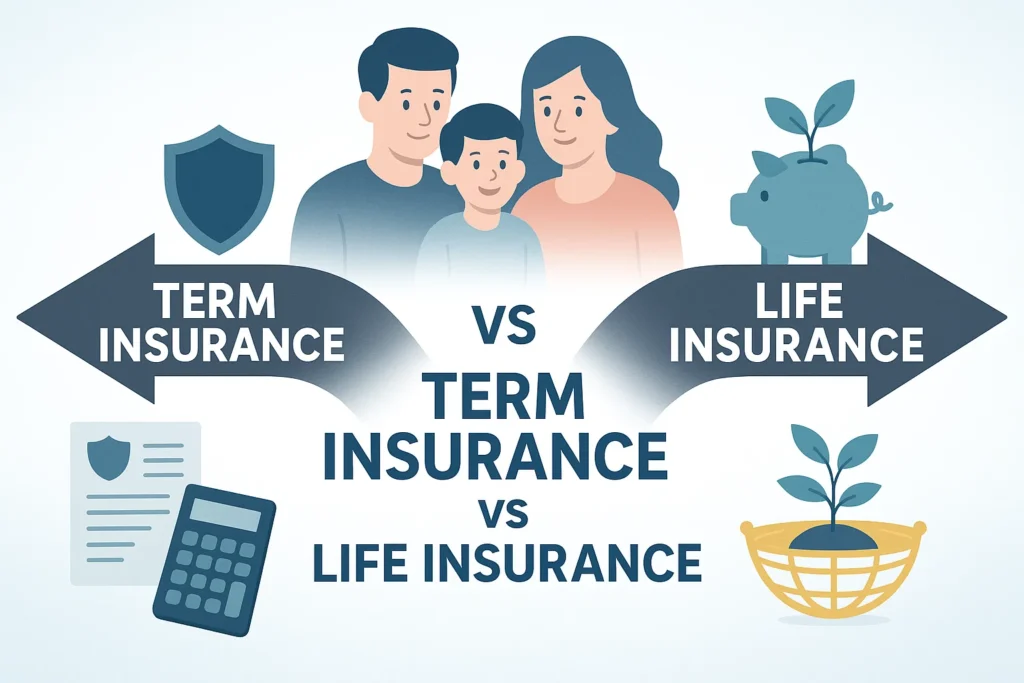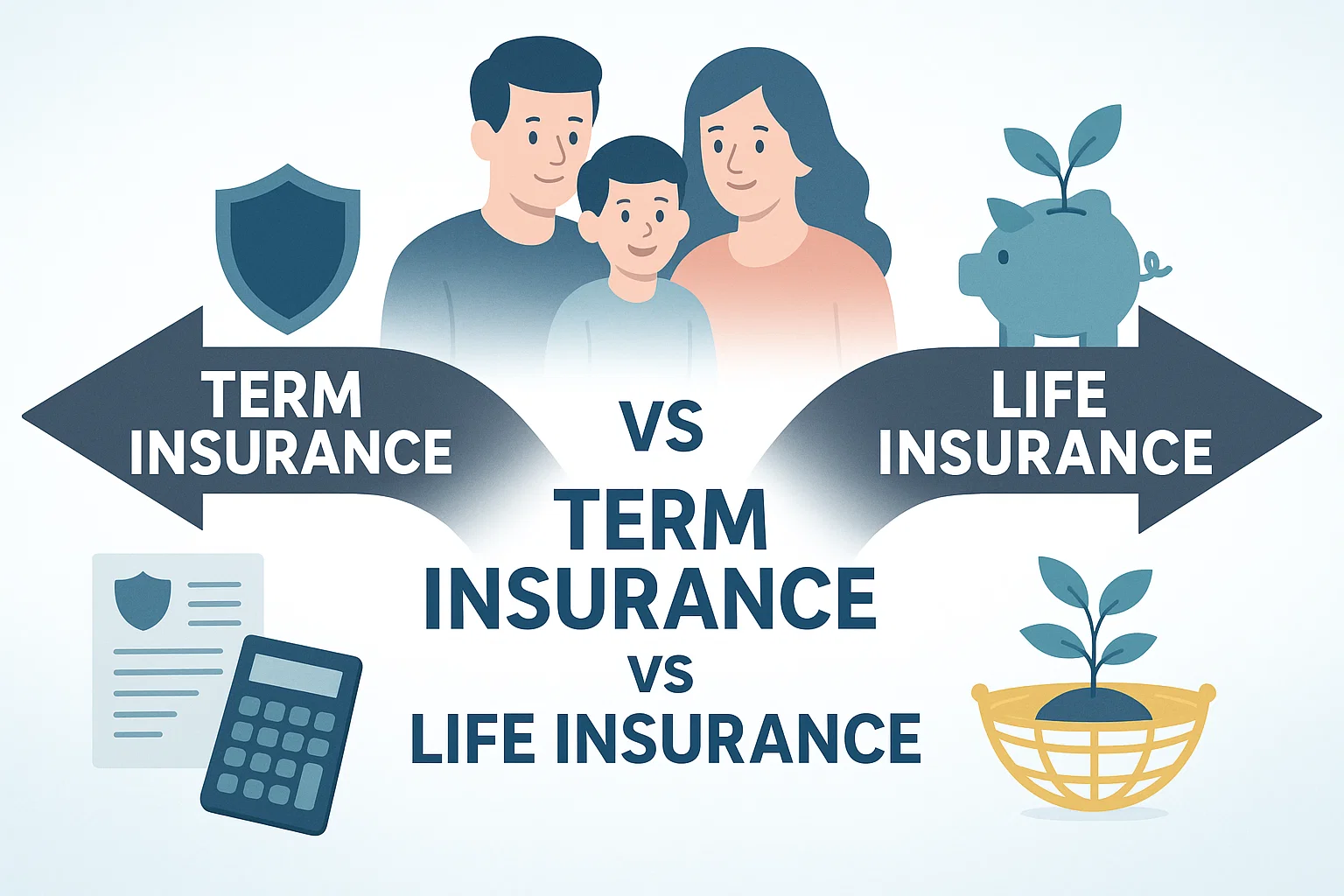
Choosing between term insurance and life insurance can be a daunting decision, especially when planning for your financial future or securing your family’s well-being. Both types of insurance serve distinct purposes, offering unique benefits and limitations. This comprehensive guide compares term insurance vs life insurance, helping you make an informed decision based on your needs, financial goals, and budget. With a clear understanding of their differences, features, and suitability, you can choose the policy that aligns best with your life stage and priorities.
What is Term Insurance?
Term insurance is a type of life insurance that provides coverage for a specific period, known as the policy term (e.g., 10, 20, or 30 years). If the policyholder passes away during this term, the nominee receives a death benefit. However, if the policyholder survives the term, no benefit is paid, and the policy expires unless renewed.
Key Features of Term Insurance
- Affordable Premiums: Term insurance plans are generally cost-effective, offering high coverage at lower premiums compared to other life insurance plans.
- Fixed Coverage Period: Coverage is provided for a specific duration, typically ranging from 5 to 40 years.
- No Maturity Benefit: If the policyholder outlives the term, no payout is provided unless the plan includes a return of premium option.
- High Sum Assured: Offers substantial coverage, often in crores, at a low cost.
- Tax Benefits: Premiums paid and payouts received are eligible for tax deductions under Section 80C and Section 10(10D) of the Income Tax Act, 1961 (subject to conditions).
- Riders: Optional add-ons like critical illness cover, accidental death benefit, or disability cover can enhance the policy’s scope.
Who Should Opt for Term Insurance?
Term insurance is ideal for:
- Young professionals or breadwinners with dependents.
- Individuals seeking high coverage at low premiums.
- Those with financial liabilities like home loans or education expenses.
- People looking for simple, straightforward life cover without investment components.
What is Life Insurance?
Life insurance is a broader category that includes various types of policies, such as whole life insurance, endowment plans, money-back plans, and unit-linked insurance plans (ULIPs). Unlike term insurance, life insurance often combines protection with savings or investment components, providing both a death benefit and a maturity benefit if the policyholder survives the term.
Key Features of Life Insurance
- Lifelong Coverage: Whole life insurance offers coverage until the policyholder’s death, regardless of age (subject to policy terms).
- Savings/Investment Component: Many life insurance plans, like endowment or ULIPs, build a corpus over time, offering maturity benefits.
- Higher Premiums: Due to the savings or investment element, premiums are generally higher than term insurance.
- Maturity Benefits: If the policyholder survives the policy term, they receive a lump sum or periodic payouts, depending on the plan.
- Tax Benefits: Similar to term insurance, premiums and payouts are eligible for tax benefits under relevant sections of the Income Tax Act.
- Flexibility: ULIPs allow policyholders to invest in equity, debt, or hybrid funds, offering potential for wealth creation.
Who Should Opt for Life Insurance?
Life insurance is suitable for:
- Individuals seeking both protection and savings/investment benefits.
- Those with long-term financial goals, such as funding retirement or children’s education.
- People comfortable with higher premiums for added benefits.
- Investors looking for market-linked returns through ULIPs.
Term Insurance vs Life Insurance: A Detailed Comparison
To help you decide, here’s a side-by-side comparison of term insurance and life insurance based on key parameters:
| Parameter | Term Insurance | Life Insurance |
|---|---|---|
| Coverage Period | Fixed term (e.g., 10, 20, 30 years) | Varies (whole life or specific term) |
| Premiums | Low and affordable | Higher due to savings/investment component |
| Death Benefit | Paid if death occurs during the term | Paid on death, regardless of timing (for whole life) |
| Maturity Benefit | None (unless return of premium option chosen) | Available in endowment, ULIPs, or money-back plans |
| Purpose | Pure risk protection | Protection + savings/investment |
| Flexibility | Limited to coverage and riders | High (investment options in ULIPs, etc.) |
| Suitability | Young families, high liabilities | Long-term financial planning, wealth creation |
Advantages and Disadvantages
Term Insurance
Advantages:
- Cost-Effective: High coverage at low premiums makes it accessible for most people.
- Simplicity: Easy to understand with no complex investment components.
- High Coverage: Ideal for securing large financial liabilities like loans or family expenses.
- Customizable: Riders allow tailoring the policy to specific needs.
Disadvantages:
- No Maturity Benefit: No payout if the policyholder survives the term.
- Temporary Coverage: Coverage ends after the term unless renewed.
- Limited Wealth Creation: No savings or investment component.
Life Insurance
Advantages:
- Dual Benefits: Combines protection with savings or investment opportunities.
- Long-Term Coverage: Whole life plans offer lifelong security.
- Wealth Creation: ULIPs and endowment plans help build a corpus over time.
- Maturity Payouts: Provides financial support even if the policyholder survives.
Disadvantages:
- Higher Premiums: More expensive than term insurance.
- Complexity: Investment-linked plans can be difficult to understand.
- Lower Returns: Traditional life insurance plans may offer lower returns compared to other investment options.
Which is Better for You?
The choice between term insurance and life insurance depends on your financial goals, life stage, and risk appetite. Here are some scenarios to guide your decision:
Choose Term Insurance If:
- You want affordable, high-coverage protection for your family.
- You have significant financial responsibilities, such as a home loan or children’s education.
- You prefer keeping insurance and investments separate for better returns.
- You’re a young professional or in the early stages of your career.
Choose Life Insurance If:
- You want a policy that combines protection with savings or investment.
- You’re planning for long-term goals like retirement or wealth creation.
- You’re comfortable paying higher premiums for additional benefits.
- You prefer a single product for both insurance and financial growth.
Key Questions to Ask Yourself
- What is your budget? If affordability is a concern, term insurance is the better choice.
- Do you need only protection or savings too? If you want savings, consider life insurance plans like endowment or ULIPs.
- What is your life stage? Young individuals may prioritize term insurance, while those closer to retirement may prefer life insurance.
- Do you have dependents? If yes, term insurance ensures their financial security at a low cost.
- What are your financial goals? Life insurance suits long-term wealth creation, while term insurance focuses on risk cover.
Tips for Choosing the Right Insurance Plan
- Assess Your Needs: Evaluate your income, expenses, liabilities, and future goals before choosing a plan.
- Compare Plans: Use online insurance aggregators to compare premiums, coverage, and benefits.
- Check Claim Settlement Ratio: Opt for insurers with a high claim settlement ratio (above 95%) for reliability.
- Consider Riders: Enhance your policy with riders like critical illness or accidental death cover for added protection.
- Read the Fine Print: Understand exclusions, terms, and conditions to avoid surprises during claims.
- Consult a Financial Advisor: If unsure, seek professional advice to align the policy with your financial plan.
Common Myths About Term and Life Insurance
- Myth: Term insurance is a waste if you survive the term.
Fact: Term insurance is designed for protection, not investment. Its low cost ensures financial security for your family. - Myth: Life insurance always offers good returns.
Fact: Traditional life insurance plans may offer lower returns compared to mutual funds or other investments. - Myth: You need only one insurance policy.
Fact: You may need multiple policies based on your goals (e.g., term for protection, ULIP for investment). - Myth: Insurance is only for the breadwinner.
Fact: Anyone with financial dependents or goals can benefit from insurance.
Tax Benefits of Term and Life Insurance
Both term and life insurance offer tax benefits under the Income Tax Act, 1961:
- Section 80C: Premiums paid (up to ₹1.5 lakh per year) are eligible for tax deductions.
- Section 10(10D): Death benefits and maturity benefits (subject to conditions) are tax-exempt.
- Section 80D: Premiums for critical illness riders may qualify for additional deductions.
Always consult a tax professional to understand applicable benefits based on your policy and income.
Conclusion
The debate of term insurance vs life insurance boils down to your priorities. If you seek affordable, high-coverage protection for your family, term insurance is the way to go. However, if you want a blend of protection and savings for long-term goals, life insurance plans like endowment or ULIPs may be more suitable. By assessing your financial needs, comparing plans, and considering your life stage, you can choose the policy that best secures your future.
For a hassle-free experience, explore trusted insurance providers and use online tools to compare policies. Whether you choose term or life insurance, ensure it aligns with your financial plan and provides peace of mind for you and your loved ones.
Disclaimer: Insurance is subject to market risks and policy terms. Always read the policy document carefully and consult a financial advisor before purchasing.

Professional finance Platform. Here we will only provide you with interesting content that you will enjoy very much. We are committed to providing you the best of finance, with a focus on reliability and 1. E-commerce Websites Purpose: Selling products or services online.

